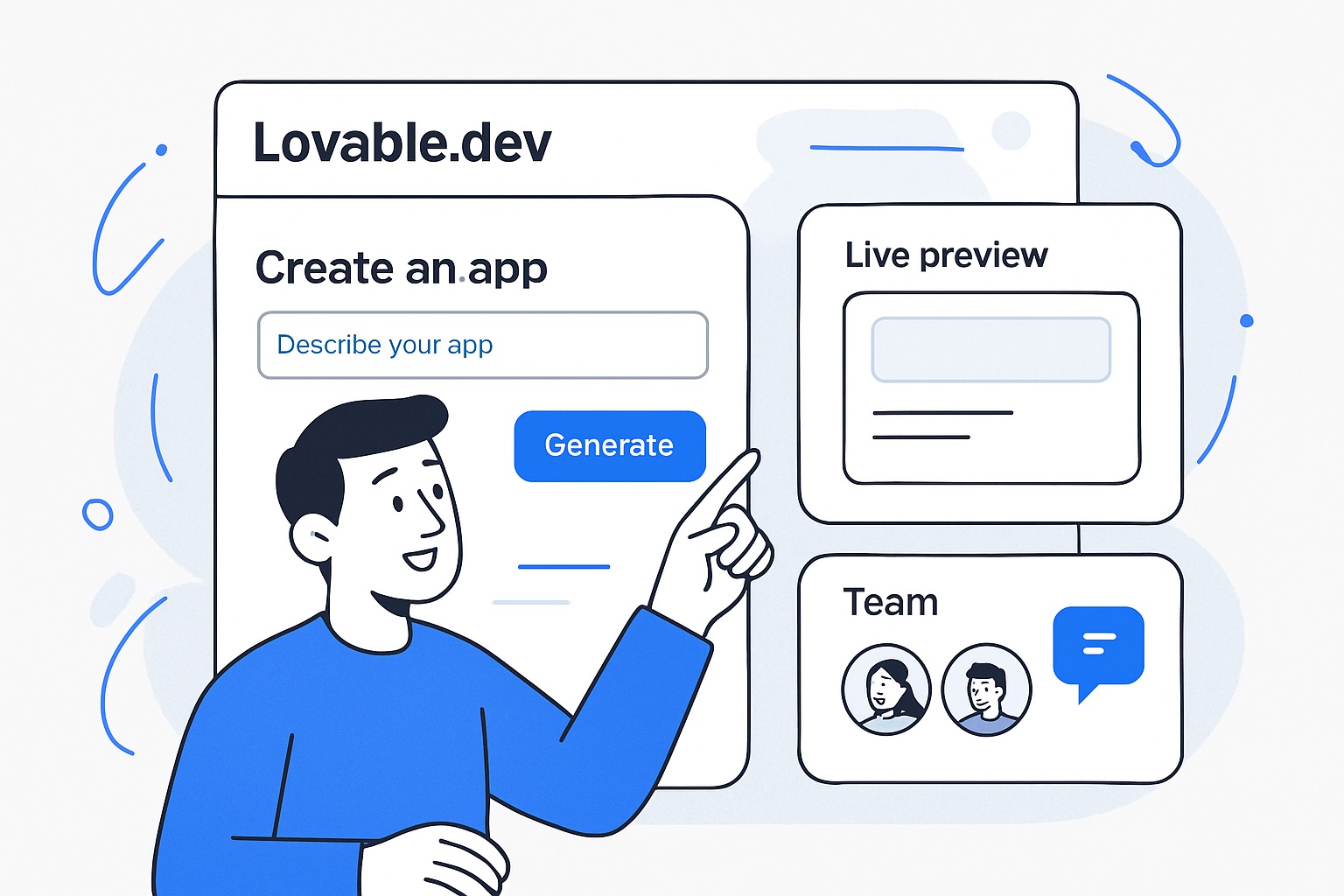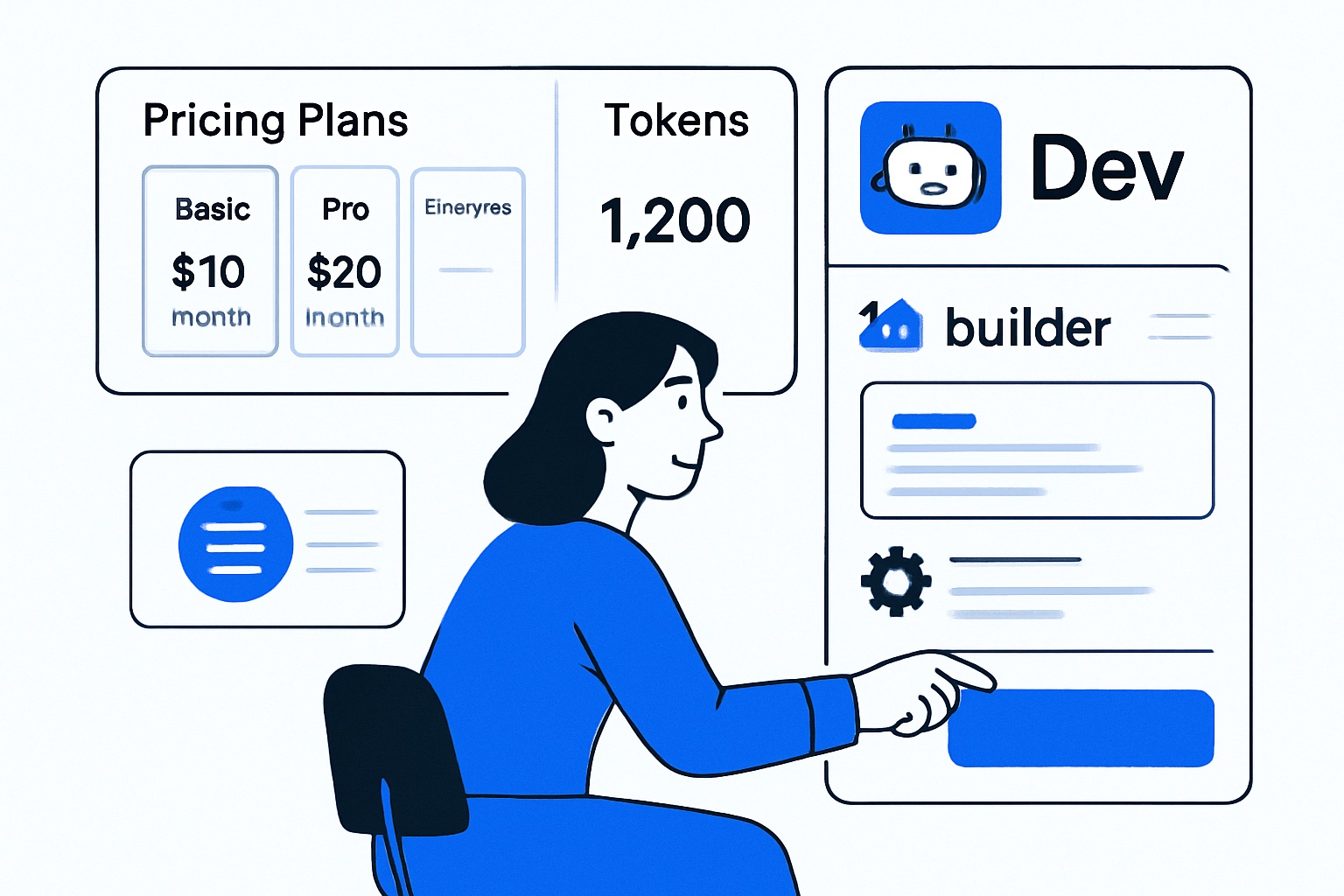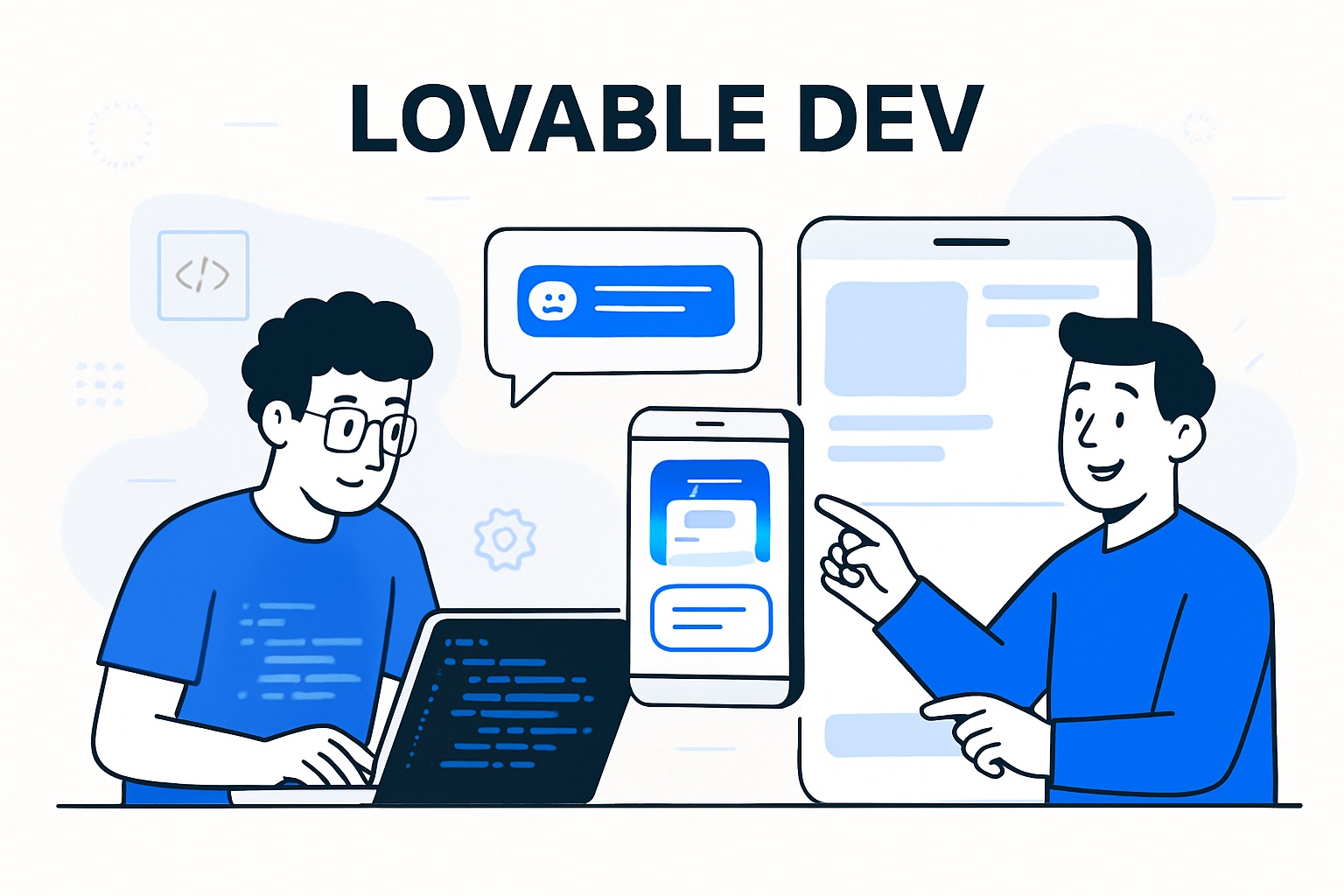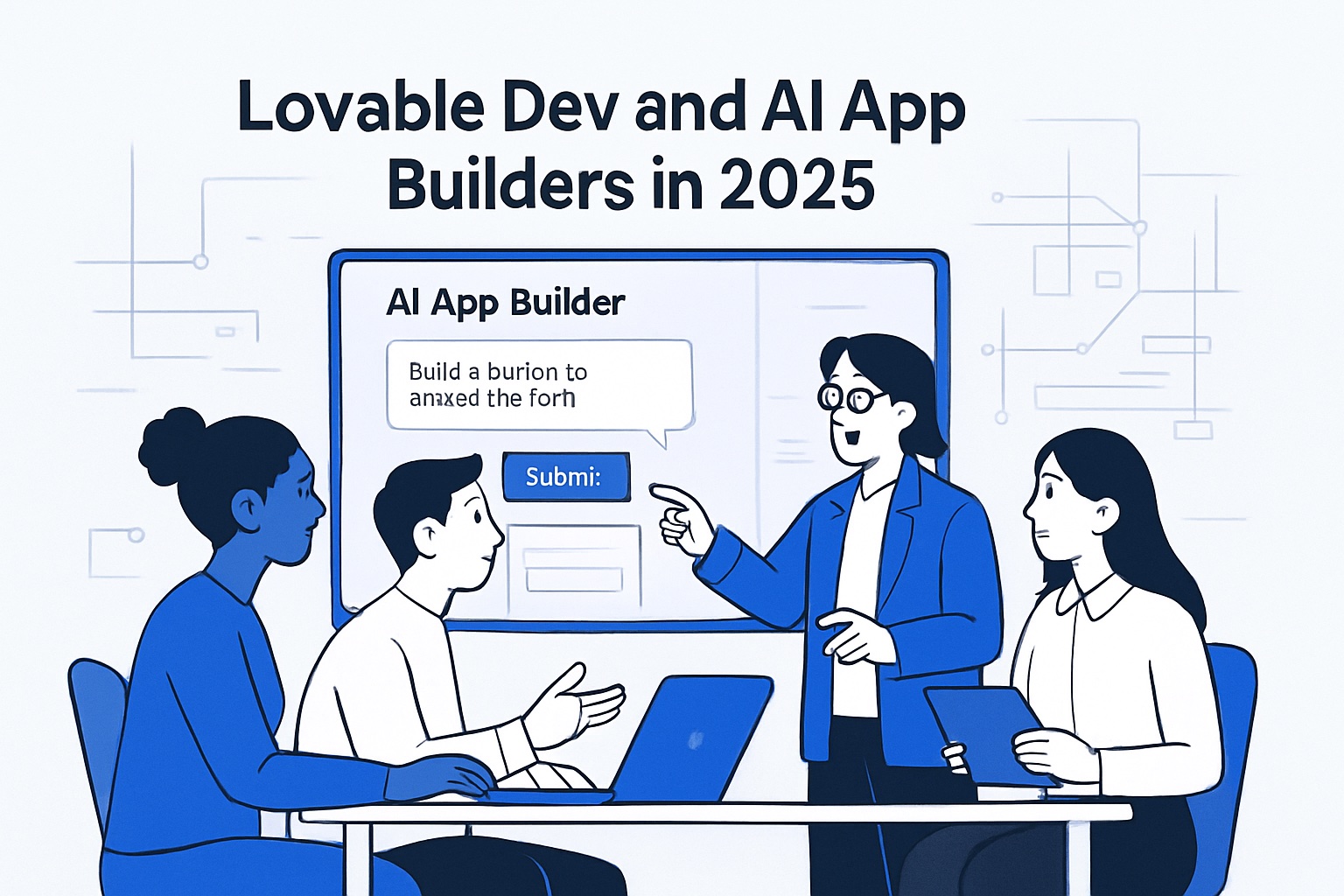Imagine building a fully functional app in just a few hours, simply by describing your idea to an AI. What seemed futuristic is now a reality thanks to rapid advances in artificial intelligence.
In 2025, AI-powered app builders are revolutionizing the way software is created. Tools like lovable dev are making development faster, more accessible, and efficient for everyone—from solo founders to large enterprises.
This guide will show you how to unlock the power of lovable dev and similar AI tools. Discover step-by-step how to set up, customize, and launch your app. Get ready to save time, cut costs, and unleash innovation with AI-driven app building.
The Rise of AI App Builders in 2025
Imagine a world where building a custom app is as easy as describing your vision. In 2025, that’s the new reality. AI app builders like lovable dev are not just buzzwords—they’re redefining how software comes to life, making the process faster, smarter, and far more accessible for everyone.
How AI is Transforming App Development
The traditional approach to app development demanded weeks of coding, debugging, and endless setup. Now, with lovable dev and similar platforms, AI is automating the heavy lifting. Generative AI (GenAI) tools handle boilerplate code, set up frameworks, and even suggest fixes in real time.
This shift isn’t just about speed. Lovable dev users often complete fully functional prototypes in as little as three to four hours—a dramatic improvement over manual methods. The impact is clear: non-technical founders and small teams can now compete with established players, launching MVPs rapidly and at a fraction of the cost.
A thriving ecosystem supports this movement. Tools like lovable dev, Replit AI Agent, and Vercel v0 offer unique strengths, from instant code generation to seamless design-to-deployment workflows. Real-world stories abound: startups are validating ideas in days, and enterprises are spinning up internal tools without waiting on IT backlogs. The result? Software creation is more democratic than ever before.
To see how these platforms stack up, check out this AI App Builders in 2025 review for a broad industry perspective. Lovable dev stands out for its natural language interface and rapid iteration capabilities.
Key Features of Modern AI App Builders
Modern AI app builders are packed with features designed to turn ideas into reality with minimal friction. With lovable dev, users simply type prompts like “Build a blog web app,” and the platform auto-generates the project structure.
Key features include:
- Natural language prompts for app creation.
- Automated project setup: frameworks, dependencies, and codebase.
- Integration with React, Tailwind, Vite, Supabase, and more.
- Built-in deployment options like Netlify integration.
- Version control and collaboration tools.
- API integrations (Stripe, OpenAI, etc.).
- AI-assisted debugging and code fixes.
What sets lovable dev apart is its real-time preview, shareable links, and the ability to edit both UI and logic instantly. This level of automation and flexibility empowers teams to focus on innovation, not infrastructure.
Who Benefits Most from AI App Builders?
AI app builders like lovable dev are game-changers for a wide range of users. Startups looking to launch MVPs quickly find tremendous value in the platform’s speed. Enterprises leverage these tools for internal dashboards and workflow automation, bypassing long development cycles.
Non-technical founders and product managers can now build and test ideas without coding expertise. Developers, too, benefit—lovable dev accelerates project scaffolding, letting them shift energy to high-impact features.
Teams focused on innovation, rather than maintaining infrastructure, thrive in this environment. Disposable systems, rapid prototypes for user testing, and short-term business tools are just a few examples where lovable dev shines. The result? Faster feedback, lower costs, and a smoother path from concept to reality.
Step-by-Step Guide: Building Apps with Lovable.dev
Building an app with lovable dev is refreshingly simple, even for newcomers to AI-powered development. This step-by-step guide walks you through the entire process—from your first login to live deployment—ensuring you get the most out of lovable dev’s capabilities. Whether you’re a founder, developer, or product manager, you’ll discover how to go from idea to working app in record time.

1. Getting Started: Sign Up and Onboarding
To begin your journey with lovable dev, head to the official website and sign up for a free account. The onboarding process is designed to be both secure and intuitive; you’ll be prompted for basic details and can enable two-factor authentication for added protection.
Once inside, lovable dev greets you with a clean dashboard and a prominent prompt field: “Ask Lovable to create an…” Here, you’ll enter your first project idea in plain English.
Security and privacy are top priorities. All your data and project details are kept confidential, and you can review privacy settings during setup. If you’re new to no-code or AI-powered tools, lovable dev offers guided tips and sample prompts to help you get started.
For a deeper dive into how platforms like lovable dev speed up software development, check out this overview of no-code solutions for faster development.
2. Defining Your Project with Natural Language
With lovable dev, you don’t need to write code from scratch. Instead, describe your app in natural language. Supported project types include web apps, dashboards, and e-commerce sites, using frameworks like React and Next.js.
For example, you might enter:Build a business dashboard with user authentication and Stripe payments.
Lovable dev’s AI interprets your prompt, selecting the appropriate stack and generating a tailored codebase. To optimize results, be clear and specific—outline required features, integrations, and design preferences.
Tips for effective prompts:
- List essential features (e.g., “with admin panel and export to CSV”)
- Specify frameworks if needed
- Mention integrations (e.g., “connect to Supabase”)
The more details you provide, the more accurate lovable dev’s output will be.
3. Customizing and Refining Your App
After your initial build, lovable dev presents a real-time preview of your app. You can share this preview with teammates or stakeholders via a unique link.
Customizing your app is easy. Use the drag-and-drop editor to adjust UI components, change filters (like switching from single to multi-select), or insert new elements. For business logic tweaks, access built-in tools like undo, version history, and rollback.
If you prefer hands-on coding, lovable dev supports direct edits through GitHub integration or your local IDE. API connections—such as Stripe for payments or OpenAI for text generation—are just a few clicks away.
Example: Want to add a custom report export? Simply describe it or edit the code directly for fine-tuned control.
4. Testing and Debugging with AI Assistance
Lovable dev takes the pain out of debugging. Its AI-powered assistant automatically detects bugs and suggests fixes, reducing manual troubleshooting.
The “Ask the AI to fix” feature is a standout—use it for unlimited bug fixes or minor tweaks without using up your message quota. For critical features, always conduct manual QA to ensure reliability.
Regression testing can pose challenges, especially as your app grows. Some users note that changes in one area may cause unexpected bugs elsewhere. For example, fixing a data export issue might inadvertently affect authentication flows.
By combining lovable dev’s AI assistance with manual validation, you’ll achieve a smoother, more reliable app-building experience.
5. Deploying Your App Effortlessly
Once satisfied with your app, lovable dev makes deployment a breeze. With just one click, you can publish to platforms like Netlify, automatically generating a live, shareable URL.
Connecting a custom domain is straightforward, and lovable dev provides clear steps for managing hosting and DNS settings. You’ll also find real-time deployment status updates and troubleshooting guidance within the dashboard.
Example: After building a prototype, share the live link with stakeholders for instant feedback—no complex setup required.
Monitoring deployment ensures your app is always accessible and up to date. Any issues can be quickly addressed using lovable dev’s integrated tools.
6. Managing Iterations and Collaboration
Collaboration is seamless with lovable dev’s version control and feedback features. Invite team members, assign roles, and track changes through detailed logs.
Iterative development is encouraged—review stakeholder feedback, make updates, and roll out improvements continuously. Export your codebase at any time for further development outside the platform.
Best practices include maintaining up-to-date documentation and using lovable dev’s change logs for transparency. This approach streamlines teamwork and ensures everyone stays aligned.
Example: Rapidly iterate on user feedback to refine features, all within lovable dev’s collaborative workspace.
Pricing and Usage: What to Expect from Lovable.dev
Curious about how much it costs to build with lovable dev? Let’s break down the pricing, usage, and practical tips so you can get the most out of this AI app builder—without surprises.

Understanding the Freemium Model and Token System
Lovable dev uses a freemium pricing model that’s highly accessible for new users. The system is based on tokens, which act as credits for each prompt, revision, or command you submit. Free users get 5 messages per day and a total of 30 per month, but unused messages don’t roll over.
Paid plans increase your quota, with options ranging from Starter (250 messages/month) up to Scale 7 (5,150/month). Each plan is designed for different project sizes and team needs.
This structure makes lovable dev cost-effective for rapid prototyping, but be mindful of your token balance as you build.
Maximizing Value: Tips and Best Practices
To get the most from lovable dev, it pays to use your tokens wisely. Start by crafting clear, well-structured prompts. Combining multiple changes into one request helps reduce token consumption.
If your project grows, upgrading to a higher plan may be more efficient than running out of credits mid-development. Remember, the “Ask the AI to fix” option is free, so use it for debugging or minor tweaks without burning through your quota.
- Batch edits whenever possible
- Monitor your usage dashboard
- Plan upgrades before hitting limits
- Use free bug fixes to stretch your tokens
Many users find they can deliver a complex app for as little as $20/month, making lovable dev a smart choice for budget-conscious teams.
Limitations and Considerations of the Pricing Model
While lovable dev offers great value, there are some important caveats. Token consumption can spike, especially during intense debugging or repeated AI requests. Some users report up to 80% of their credits going toward bug fixes or repeated prompts.
Each AI response can take 30–90 seconds, which adds up if you’re iterating quickly. For large projects or teams, these factors might impact workflow and overall cost. Still, when you compare lovable dev to the time and expense of traditional development, it remains a compelling option for many use cases.
When to Consider Agency Support for AI App Development
There are times when lovable dev alone might not be enough. If your project requires complex scoping, custom integrations, or advanced security, partnering with an agency can make a big difference. Agencies bring expertise that helps navigate limitations, ensuring robust compliance, design, and deployment.
Complex enterprise apps, demanding integrations, or strict QA standards often benefit from combining lovable dev with professional oversight. For mission-critical solutions, expert support helps avoid pitfalls and accelerates delivery.
How Big House Technologies Can Help
As a top-tier no-code and AI development agency, Big House Technologies specializes in building scalable, production-ready apps on platforms like lovable dev and Bubble. Their services cover the full project lifecycle, from scoping and design to QA and deployment.
With a proven track record for startups and enterprises, they offer cost-effective, rapid delivery—perfect for businesses needing expert guidance or advanced automation. Learn more about their approach and see how they can help bring your vision to life: Big House Technologies.
AI Code Generation vs. Traditional Development
The landscape of software development is undergoing a dramatic shift, with tools like lovable dev leading the way. Today, the process of building an app can look radically different depending on whether you rely on traditional manual coding or embrace AI-powered platforms. Let’s break down the core differences and see how lovable dev is reshaping the journey from idea to deployment.

Comparing Development Workflows
Traditionally, developers start by setting up frameworks, installing dependencies, and configuring environments. This manual process requires deep technical knowledge and can take days just to get a project scaffolded. Every feature is hand-coded, from authentication to UI layouts.
With lovable dev, the workflow is transformed. You describe your app in plain English, and the platform generates the initial codebase, configures dependencies, and even scaffolds the UI automatically. According to recent AI in Software Development Statistics, teams using AI builders like lovable dev can create working prototypes in 3-4 hours compared to weeks of manual development.
This shift empowers non-technical founders and small teams to bring ideas to life without writing a single line of code. For developers, lovable dev eliminates tedious setup, letting them focus on unique logic and value-add features.
Speed, Flexibility, and Customization
One of the most compelling advantages of lovable dev is speed. AI excels at generating boilerplate code and repetitive components, slashing hours from the development process.
However, while lovable dev is fantastic for rapid prototyping and MVPs, it can struggle with highly custom requirements. Traditional coding offers complete control, allowing for deep customization and fine-tuning. If your project has complex business logic or needs to handle edge cases, you may find AI-generated code needs manual refinement.
Still, for most standard app features—authentication, dashboards, integrations—lovable dev delivers flexibility and quick results, making it an ideal choice for startups and internal tools.
Deployment and Maintenance
Deploying an app traditionally involves setting up hosting, configuring CI/CD pipelines, and troubleshooting deployment errors. This process can be error-prone and slow, especially for small teams.
With lovable dev, deployment is streamlined. You get one-click publishing to platforms like Netlify, instant live URLs, and simple domain management. Maintenance is also easier at first, since lovable dev handles updates and infrastructure.
That said, lovable dev-generated code may require more QA after major changes. Regression issues can surface when features are updated, so manual validation remains important.
Security, Quality, and Oversight
Security is always a top concern. While lovable dev accelerates development, it can introduce risks if not carefully reviewed. AI-generated code may lack proper access controls or suggest insecure configurations.
For example, there have been instances where lovable dev created password-less authentication flows that exposed user data. That’s why expert oversight is crucial, especially for public-facing or sensitive apps. It’s wise to perform security audits and code reviews before launch.
Ultimately, lovable dev is a powerful co-pilot, but not a replacement for human judgment. Combining the speed of AI with professional QA and security practices ensures your app is both robust and safe.
Limitations, Pitfalls, and Best Practices for AI-Driven App Development
Building with lovable dev and similar AI-powered platforms is exciting, but it’s not without its hurdles. Understanding these challenges and adopting best practices ensures your projects run smoothly and securely.
Common Challenges and Workarounds
AI-driven platforms like lovable dev can sometimes feel unpredictable. You may find yourself repeating prompts to get the desired outcome or fixing logic that doesn't quite work as expected. Debugging can be time-consuming, especially when AI-generated code introduces new bugs or breaks existing features.
- Inconsistent AI responses
- Repeated prompts for similar issues
- Dead time waiting for AI responses
- Regression bugs from iterative changes
A common scenario is asking lovable dev to fetch a full product list, only to need several attempts for complete results. According to recent insights on AI Adoption in Software Development, many developers struggle with trust and spend significant time on debugging. Staying patient and using batch changes can help minimize frustration.
Security and Compliance Risks
Security is a critical concern when using lovable dev for app creation. AI-generated code may unintentionally introduce vulnerabilities, such as open database access or weak authentication flows. These risks are often not flagged by the platform, so it’s essential to conduct thorough code reviews and audits before deploying public-facing apps.
- Insecure database policies
- Lack of explicit security warnings
- Exposure of sensitive data (e.g., user emails)
- Compliance gaps for regulated industries
For example, lovable dev might recommend database policies that inadvertently expose user email addresses. Always involve an expert review for projects handling personal or business-critical information to ensure compliance and security.
Scalability and Long-Term Maintenance
While lovable dev shines for rapid prototyping and internal tools, scaling these solutions can be challenging. AI-generated code may not follow best practices for maintainability or performance, making it harder to extend or optimize as your app grows.
- Difficulty customizing beyond standard templates
- Limited scalability for complex applications
- Knowledge gaps from over-reliance on AI
- Best suited for MVPs, disposable tools, or internal business apps
A typical case is a business reporting system built quickly on lovable dev that later requires manual oversight to scale. For internal tools, platforms like lovable dev are highly effective; learn more about this in No-code for internal tool development.
Best Practices for Success with AI App Builders
To get the most out of lovable dev, focus on these best practices:
- Use AI for initial scaffolding, then refine manually
- Write clear, structured prompts and iterate features
- Maintain project documentation and use version control
- Always review generated code for quality and security
- Engage agencies or technical leads for mission-critical apps
A proven workflow is to let lovable dev handle the boilerplate, then hand off to experienced developers or agencies for final polish. This approach maximizes speed and safeguards your app’s quality.
Top Alternatives to Lovable.dev and the Future of AI App Development
Choosing the right AI-powered app builder can be a game-changer for your next project. While lovable dev is making headlines, 2025 is packed with innovative alternatives that push the boundaries of rapid software creation. Let’s explore these options, how to pick the best fit, and what the future holds for AI-driven development.
Leading AI App Builder Alternatives in 2025
The landscape for AI app builders is evolving rapidly. While lovable dev leads in natural language-driven app creation, several top contenders have emerged:
- Replit AI Agent integrates directly into the coding environment, assisting with code suggestions and auto-fixes. It’s ideal for those who want to build beyond what lovable dev offers, especially if you prefer hands-on coding.
- Vercel v0 shines for developers who want to turn ideas into visually appealing UIs with minimal fuss. It’s perfect for rapid front-end prototyping, much like lovable dev’s UI builder.
- Bolt.new takes a holistic approach, automating boilerplate across both front- and back-end. It’s great for startups wanting to launch full-stack MVPs without building from scratch.
Each of these platforms offers unique strengths. If lovable dev fits your workflow, you’ll appreciate how these alternatives expand your toolkit. The ecosystem is growing, giving creators more options for different project needs.
Choosing the Right AI Tool for Your Needs
Not all projects are created equal, so picking the right platform is essential. Start by defining your primary goal: Are you building a quick prototype, an internal tool, or a production-ready app? If lovable dev excels at rapid MVPs, Replit AI Agent might suit code-heavy projects, while Vercel v0 is a go-to for UI-focused tasks.
Consider your team’s expertise. Non-technical founders often prefer lovable dev for its simplicity. Developers seeking flexibility might lean toward Bolt.new or Replit. Budget and required integrations also play a role.
For a deeper dive into how AI and no-code are reshaping software creation, check out Future of software for enterprises and startups.
The Evolving Role of AI in Software Development
AI is no longer just a tool; it’s becoming a co-engineer. Platforms like lovable dev empower creators by automating setup, code generation, and even debugging. However, AI isn’t replacing developers—it’s amplifying their creativity and productivity.
Expect even more reliable, customizable, and secure AI-driven workflows in the near future. As lovable dev and its peers mature, we’ll see smarter integrations with DevOps and cloud platforms, making the software lifecycle smoother than ever.
The democratization of app development is accelerating, bringing new voices and ideas into the tech world. For a comprehensive look at AI’s broader impact, see AI's Impact on Software Development.
Staying Ahead: Resources and Further Reading
Staying up-to-date is key as lovable dev and other platforms evolve. Here’s how you can keep learning:
- Follow official blogs and documentation for lovable dev, Replit AI Agent, Vercel v0, and Bolt.new.
- Join online communities and forums focused on AI app development.
- Explore technical articles and case studies on new AI workflows.
- Seek out tutorials and webinars for hands-on learning.
Continuous learning ensures you leverage lovable dev and its alternatives to the fullest, no matter how quickly the landscape changes.
Ready to turn your app idea into reality—without months of coding or endless back-and-forth? In this guide, you’ve seen how AI-driven platforms like Lovable.dev can help you build, test, and launch functional apps faster than ever before. Whether you’re a founder aiming to validate an MVP or a team looking to innovate quickly, leveraging no-code and AI tools can be a real game-changer for speed and budget. If you’re inspired to move from concept to launch on a timeline that fits your ambition, don’t wait—Launch Your MVP in Weeks, Not Months.

About Big House
Big House is committed to 1) developing robust internal tools for enterprises, and 2) crafting minimum viable products (MVPs) that help startups and entrepreneurs bring their visions to life.
If you'd like to explore how we can build technology for you, get in touch. We'd be excited to discuss what you have in mind.
Other Articles
Discover the 12 best low code platforms for 2025. Compare features, pricing, and use cases to find the right solution for your business needs and boost agility.
Unlock rapid app development in 2025 with this low code guide Explore benefits challenges step by step adoption and real world use cases for innovation
Discover the ultimate guide to developing application in 2025. Learn step-by-step strategies, best tools, and key tips to launch your first app successfully.

